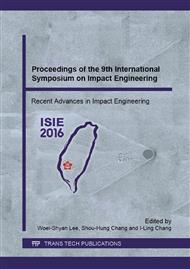p.80
p.86
p.95
p.101
p.107
p.111
p.116
p.122
p.128
Effect of Acrylic Foam Film on Impact Reduction
Abstract:
Recently, Thin Foam Films are Applied to Cushion Materials on Various Instruments, such as Mobile Phones, Tablet Computers, Etc. because of Reducing Load due to Drop Impact or Collision. Testing Methods of the Thin Films must Be Established to Estimate Effect of Thin Films on Reduction of the Impact Load. in this Research, Impact Reduction Effect of the Acrylic Foam Film with a Thickness below 1000μm was Clarified by Developing a Falling Weight Testing Machine. Maximum Value of the Impact Load Decreased Dominantly and the Plateau Region was Longer as the Thickness Increased. the Duration of the Load was Longer for the Thicker Film. Therefore, the Thin Acrylic Foam Films were Found to Be Effective in the Reduction of the Large Impact Load over 20 Kn.
Info:
Periodical:
Pages:
107-110
Citation:
Online since:
September 2016
Authors:
Keywords:
Price:
Сopyright:
© 2016 Trans Tech Publications Ltd. All Rights Reserved
Share:
Citation:


